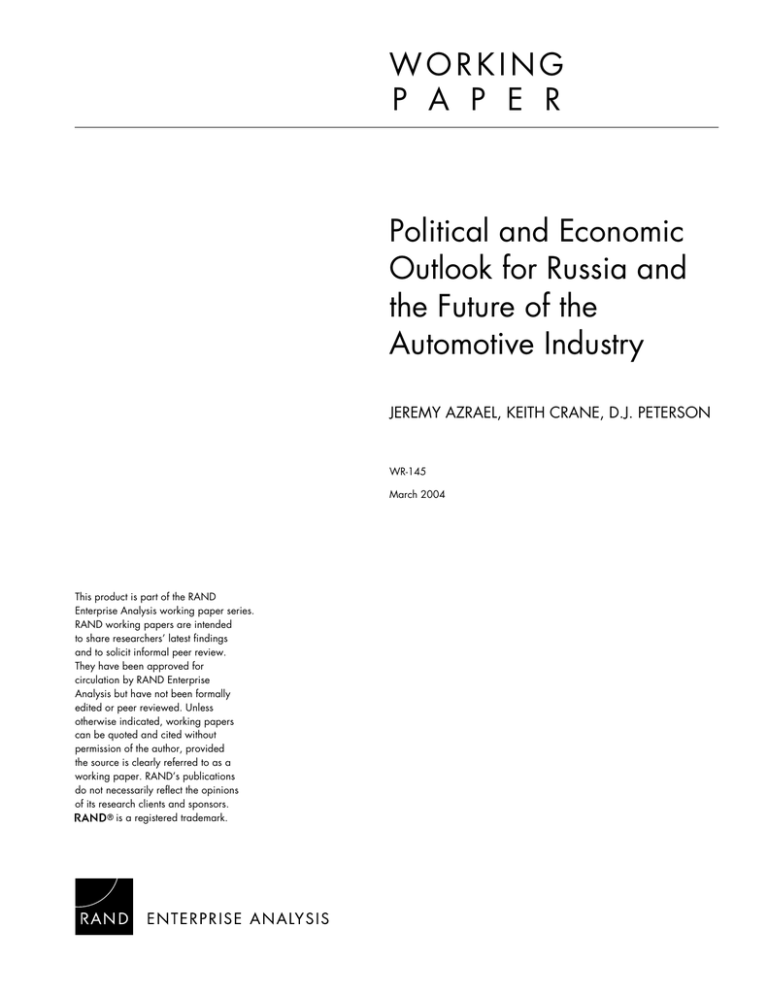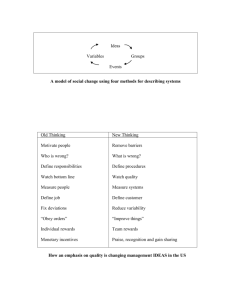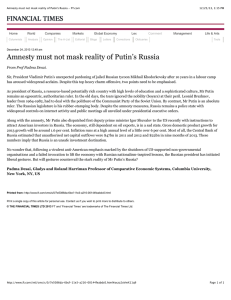Document 12781579
advertisement

WORKING P A P E R Political and Economic Outlook for Russia and the Future of the Automotive Industry JEREMY AZRAEL, KEITH CRANE, D.J. PETERSON WR-145 March 2004 This product is part of the RAND Enterprise Analysis working paper series. RAND working papers are intended to share researchers’ latest findings and to solicit informal peer review. They have been approved for circulation by RAND Enterprise Analysis but have not been formally edited or peer reviewed. Unless otherwise indicated, working papers can be quoted and cited without permission of the author, provided the source is clearly referred to as a working paper. RAND’s publications do not necessarily reflect the opinions of its research clients and sponsors. is a registered trademark. vii EXECUTIVE SUMMARY This Working Paper assesses political developments and trends in Russia since independence and discusses likely future developments under President Vladimir Putin through 2008—the end of his second presidential term. It then evaluates the sources of recent economic growth in Russia and projects economic output and personal incomes through 2002. The third section of the paper analyzes the Russian car market and car manufacturing industry and forecasts automobile sales by volume and segment through 2020. Political Developments and Trends in Russia In some respects, the political transition since the end of the former Soviet Union has gone better than feared. Russia did not disintegrate as the USSR did and Boris Yeltsin established an institutional framework and cultural baseline for the potential emergence of a “normal” and “civilized” political system to which he and many other “founding fathers” of Russia aspired. However, imperfections in the reform process combined with Yeltsin’s personal infirmity during his second term fostered a chaotic economic and political environment which undermined support for liberal reforms. Vladimir Putin has been very popular in Russia because of his success in restoring a sense of political and economic “order.” Since 1998, Russia’s economy has grown rapidly, in part because of the economic policy and institutional changes implemented under Yeltsin, bolstered by a period of relatively high energy prices. The Putin administration also has improved the provision of basic government services, most notably the regular payment of pensions and government salaries. An extensive tax reform introduced during his tenure and spending restraint have put the government budget on a sounder basis. In his second term, we expect that Putin will seek to deepen and extend market reforms and further promote economic restructuring and development. Putin has utilized the relative stability of his first term as president to set the stage for a more centralized and authoritarian political system. We see a continuation, if not intensification of this trend during his second term in part because of his strong control over the parliament and “administrative resources” of the state and also because a semi-authoritarian government is in line with the stated preferences of a significant share of the population. However, we feel a full-fledged dictatorship is neither generally viii desired nor feasible. We expect the Russian public will remain largely politically apathetic and passive. The general quiet that prevailed during the economic and social traumas experienced in the 1990s suggest that Russians will continue to focus on their personal affairs. Political stability is likely to last at least through Putin’s second term (2004-2008). We do envision escalating political power struggles as the 2008 elections draw near and candidates jockey for position and influence, should Putin not seek to change the constitutional prohibition against a third term. How Rich is Russia? How Much Richer Will it Be? Russia has enjoyed rapid economic growth since 1998. Gross Domestic Product (GDP) has risen by 37 percent, an average annual increase of 6.5 percent per year, one of the highest growth rates among the larger medium-developed economies. The expansion of the last five years has been driven by different sectors at different times. Initially, the sharp depreciation of the ruble in 1998 and 1999 resulted in a surge in non-energy industrial output as Russian manufacturers of foodstuffs, machinery, and metals increased exports or took domestic market share from imports. Output of services fell in 1999, but since 2000 growth in market services has led the recovery. Russia has a medium-sized economy. In 2002, GDP totaled $347 billion at market exchange rates; Brazil’s GDP was $452.4 billion and Italy’s was $1,187 billion. Another way of sizing economies is to use purchasing power parity (PPP) exchange rates. Russia’s GDP at PPP rates is much higher than at market rates. At PPP rates, Russia’s GDP was $1,042 billion in 2002, about the same size as Brazil’s ($1,324 billion) or Italy’s economy ($1,432 billion) at PPP exchange rates. Five risks that are generally considered to threaten continued growth in Russia: 1) Continued high inflation, 2) A banking crisis, 3) A sharp drop in world market oil prices, 4) A worsening business environment, and 5) Failure to liberalize trade by joining the WTO. In our view, the biggest threat to continued economic growth in Russia would be the failure to lower barriers to trade and remove impediments to private business activity. Russia under Putin has made progress in making business law more transparent and reducing the power of the bureaucracy to threaten the activities of legitimate businesses. ix Judges have been made more independent and some corrupt officials have been replaced. However, the business environment could easily deteriorate. If it worsens, Russian economic growth prospects would dim. We project the Russian economy will grow at an average annual rate of 4.0 percent between 2005 and 2020. This is in the mid-range of economic performance in the transition economies after they resume growth. Lower income transition economies have generally enjoyed more rapid rates of growth, but the Central European states have registered growth at around 4.0 percent. Some countries, like the Czech Republic have grown at much slower average annual rates. The poor condition or absence of critical infrastructure, corruption, continued barriers to trade, slow growth in the labor force, and lack of foreign investment make much more rapid growth for Russia highly unlikely. Outlook for the Russian Car Market to 2020 Currently, most Russian car buyers tend to be in the top 20 percent of the population in terms of income, with most of the remainder falling in the top 40 percent. Russian ownership levels of 154 cars per thousand people are 60 percent of ownership levels in the wealthier Central European states of Poland and Hungary, reflecting lower Russian incomes. However, roughly one in four households in Russia still owns a car, one in two in Moscow. The Russian market is divided into three distinct segments: new cars sold by the Russian manufacturers, used foreign imports, primarily from Germany and Japan, and new foreign imports. In a market of 1.5 million units, until recently sales of new foreign cars had been well under 100,000 units a year. However, in 2003, sales doubled to 200,000 new imported vehicles. By 2020, should economic growth continue, we project that the Russian market will double to 3 million units per year, most of which will be foreign makes. The future of Russian automobile makers is bleak. AvtoVAZ, Russia’s largest automobile manufacturer, is plagued by low levels of productivity, poor quality, old assembly lines, and a lack of capital to introduce new models. Despite these problems, AvtoVAZ is likely to be the only remaining independent Russian manufacturer by 2020. Second-tier companies such as GAZ and UAZ, which have been acquired by aluminum and steel giants and are being restructured, are likely to be sold to foreign buyers or closed. x Responding to the evolution in Russia’s automobile market, foreign firms, including Ford, General Motors, and Renault, have recently begun to invest in assembly operations. By 2020, we project that foreign firms will be responsible for almost twothirds of the 1.8 million cars forecast to be manufactured in Russia. The market share of new foreign cars, including domestically produced and imports, is projected to run 64 percent of new registrations in 2020. Russia’s government currently lacks the resources and the political desire to provide significant support to Russian manufacturers. The government does provide some incentives, mainly tariff reductions on imported parts to foreign operations. By 2010, Russian and the European Union may have signed a free trade agreement, liberalizing trade in automobiles and components, accelerating cooperation between Russian manufacturers and their foreign counterparts.








